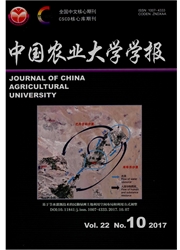

 中文摘要:
中文摘要:
为明确不同耕作方式下土壤腐殖质结合形态及组成的变化规律,依托8年定位耕作试验,采用大田取样、室内分析相结合的方法对其进行了研究。结果表明:各种耕作方式下土壤腐殖质均以紧结态腐殖质为主,其含量占重组有机碳的50%以上;传统耕作方式(CTA)松结态、稳结态腐殖质含量随试验年限延长而增加,但紧结态腐殖质含量及其在重组碳中所占比例呈下降趋势,传统耕作方式下腐殖质趋向于分解退化;旋耕秸秆还田方式(RTS)松结态、紧结态腐殖质含量年增加速率分别达0.08和0.31 mg/g,且其稳结态腐殖质含量最高,旋耕秸秆还田有利于土壤腐殖质的更新与积累;土壤耕作及由此引起的秸秆分布位置不同是促进对应层次松结态腐殖质含量增加的重要原因;秸秆还田条件下对土壤的扰动,增加了土壤的腐殖化度。
 英文摘要:
英文摘要:
The dynamic of combined forms of humus and humus components in different tillage practices that lasted for eight years were studied through a method combining field sampling and lab analysis.The results were as follows.The majority of combined humus in different tillage practices was tightly combined humus which represented more than 50% of total heavy fraction organic carbon.The loosely combined and stably combined humus increased with continuous conventional tillage(CTA) practice.But the content of tightly combined humus and its share in heavy fraction organic carbon decreased.It was evidenced that humus was preferred to degradation under CTA.The annual increasing rates of loosely combined and tightly combined humus in rotary tillage(RTS) were 0.08 and 0.31 mg/g respectively.In addition,the stably combined humus of RTS was the highest one among all the tillage practices.RTS led to an acceleration of humus accumulation and renewal.The main cause of the acceleration of loosely combined humus accumulating in corresponding layer was the depth of tillage operation and the position of straw displaced by that.The humification degree of soil was enhanced by combination of straw returning and disturbance of tillage.
 同期刊论文项目
同期刊论文项目
 同项目期刊论文
同项目期刊论文
 期刊信息
期刊信息
